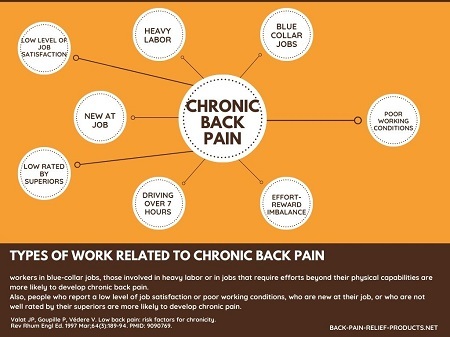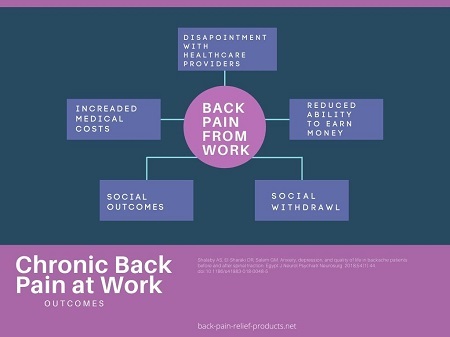Back pain (especially lower back pain) prevalence is rising steadily in the past years, with 12%-44% suffering from back pain at any given time, and is the most common cause of work-related disability in people under 45 years of age.
In this post, you’ll find the latest statistics, studies, and facts about work-related back pain, its major causes, and how to prevent it (or at least relieve it.
Let’s dive right in.
Overview
- What Kind of Work is Most Likely to Cause Chronic Back Pain?
- Work-Related Back Pain Statistics & Studies
- 23%-38% Prevalence of Lower Back Pain Among Office Workers
- Driving for More Than 4 Hours May Be Correlated with Back Pain in 51% of Drivers
- Sitting in an Awkward Posture Quadruples Lower Back Pain Risk
- Sitting in “Good Posture” Does Not Necessarily Prevent Back Pain
- Work-Related Psychological Problems Increase Chance of Back Pain
- Lower Back Pain is the Most Expensive Cause of Work-Related Disability
- Chronic Back Pain Sufferers Deal with More Anxiety
- Spinal Traction Reduces Back Pain, Anxiety and Depression Among Patients
- Chronic Back Pain Sufferers Spend $2500 Annually for Medical Care
- Back Pain is a Leading Cause of Work Limitations
- Conclusion
What Kind of Work is Most Likely to Cause Chronic Back Pain?

According to aggregated data, workers in blue-collar jobs, those involved in heavy labor or in jobs that require efforts beyond their physical capabilities are more likely to develop chronic back pain.
Also, people who report a low level of job satisfaction or poor working conditions, who are new at their job, or who are not well rated by their superiors are more likely to develop chronic pain.
Work-Related Back Pain Statistics & Studies
Here are the latest statistics and studies about back pain at/work:
23%-38% Prevalence of Lower Back Pain Among Office Workers
Self-reported muscle-spine symptoms attributed to work have now reached 63%, and 23%-38% of office workers suffer from lower back pain lasting a year.
The major areas of complaint are the head/neck (42%), low back (34%), upper back (28%), shoulders (16%), and hips (6%). Female workers are more likely to report symptoms in the neck, shoulder, and upper back areas than males. (Source)
According to this study, 51% Of 1242 taxi drivers have reported lower back pain in the past year, while 33% of other professional drivers also report the same symptom.
Driving time over 4 hours a day increases the chance of low back pain, along with frequent bending, job stress, and job dissatisfaction.
Sitting in an Awkward Posture Quadruples Lower Back Pain Risk
According to this study, sitting in an awkward posture was independently associated with the presence of sciatica and/or lower back pain. This risk quadruples when sitting is accompanied by whole-body vibration (like when driving a truck).
However, surprisingly, sitting was not correlated with an increased risk of back pain.
We’ve found a few surprising studies that all claim that sitting for long hours does not cause back pain; it’s the lack of movement and position change that increases the prevalence of it.
RELATED: The 6 Best Office Chairs for Back Pain in 2023
Sitting in “Good Posture” Does Not Necessarily Prevent Back Pain
There’s still a debate about the correct sitting posture for computer work or prolonged driving, when some studies suggest that the right posture is subject-specific.
However, studies have found that sitting in the correct posture may not prevent back pain if the person sits without changing position or getting up for more than 7 hours.
Changes in posture during sitting were actually linked to a reduction in spinal loads and spinal shrinkage.
Work-Related Psychological Problems Increase Chance of Back Pain
The link between back pain and stress is getting clearer as more studies find that various psychological problems are correlated to lower back pain.
These problems include high stress, low social support, low job satisfaction, and effort-reward imbalance (people who feel they are not being paid according to their effort).
For example, this study has found a significant connection between effort-reward imbalance and the incidence of back and neck injuries.
Lower Back Pain is the Most Expensive Cause of Work-Related Disability
LBP is the most common cause of work-related disability in people under 45 years of age and the most expensive cause of work-related disability when it comes to workers’ compensation and medical expenses (study).
In the USA, the total yearly cost of lower back pain is more than 100 billion dollars (study).
Chronic Back Pain Sufferers Deal with More Anxiety

People who suffer from chronic back pain tend to feel more worried and afraid about increased medical costs and the inability or reduced ability to earn money, worried about social outcomes, and experiencing social withdrawal, and disappointment with healthcare providers (study)
Spinal Traction Reduces Back Pain, Anxiety and Depression Among Patients
While there are still not many studies proving the effectiveness of spinal decompression for back pain, this study has found a significant reduction in pain, anxiety and depression, and quality of life when people were treated with spinal traction (combined with medication).
See the 10 Best Spine Decompression Home Devices, and the best spinal decompression exercises.
Chronic Back Pain Sufferers Spend $2500 Annually for Medical Care
According to a study cited by WebMD, the average estimated annual medical expenditures for people suffering from back pain in 2005 was $2580 more than those without pain.
A 2008 study in the Journal of the American Medical Association found that this steady increase in treatment costs for back pain did not correspond with an improvement in patient outcomes.
In other words, going to healthcare providers (especially general practitioners) does not mean you’ll feel better in the long run.
Find out how some back pain home treatments, such as back stretchers, vibrating foam rollers, back roller wheels – can effectively relieve your back pain and save you thousands on your medical costs.
We also recommend an inversion table and a good hybrid mattress for back pain, to prevent back pain at night, and an infrared heating pad – to relieve back pain naturally when you work.
Back Pain is a Leading Cause of Work Limitations
According to the Health Policy Institute, over 4 million adults report that they have had difficulties getting a job or keeping it – due to back pain.
It is the leading cause of work limitations among adults ages 18 to 64, and among adults age 65 and older, back pain is the fourth leading cause of work limitations.
And:
Among those who have difficulties at work caused by back pain, annual earnings are substantially lower than those who do not experience any difficulties at work. Differences are greatest among younger workers.
Conclusion
While we can’t stop the aging process, and too often we can not just quit our jobs, it is possible to take care of your body and minimize the risk of back pain at work (and after work hours).
The studies and statistics show that sitting at the office or when driving won’t necessarily cause back pain if you make sure to move around, change your posture or just change your sitting position a few times.
Reducing job stress is also essential to preventing work-related back pain, and through our experience, daily stretches quickly relieve stress while increasing your blood flow and preventing stagnation.
While seeing a healthcare provider (And paying a lot of money) does not guarantee any positive result, some studies and thousands of people report spine decompression to be effective.
When you add that to taking care of your health (no more smoking, exercising a bit, and changing your diet) – your entire body benefits, and the chances of suffering from anxiety and depression are significantly lower.
The Back Pain Relief Products Team
Studies
Janwantanakul P, Pensri P, Jiamjarasrangsri V, Sinsongsook T. Prevalence of self-reported musculoskeletal symptoms among office workers. Occup Med (Lond). 2008 Sep;58(6):436-8. doi: 10.1093/occmed/kqn072. Epub 2008 Jun 10. PMID: 18544589.
Chen JC, Chang WR, Chang W, Christiani D. Occupational factors associated with low back pain in urban taxi drivers. Occup Med (Lond). 2005 Oct;55(7):535-40. doi: 10.1093/occmed/kqi125. Epub 2005 Sep 1. PMID: 16141293.
Lis AM, Black KM, Korn H, Nordin M. Association between sitting and occupational LBP. Eur Spine J. 2007 Feb;16(2):283-98. doi: 10.1007/s00586-006-0143-7. Epub 2006 May 31. PMID: 16736200; PMCID: PMC2200681.
Valat JP, Goupille P, Védere V. Low back pain: risk factors for chronicity. Rev Rhum Engl Ed. 1997 Mar;64(3):189-94. PMID: 9090769.
Janwantanakul P, Pensri P, Moolkay P, Jiamjarasrangsi W. Development of a risk score for low back pain in office workers–a cross-sectional study. BMC Musculoskelet Disord. 2011;12:23. Published 2011 Jan 25. doi:10.1186/1471-2474-12-23
Rugulies R, Krause N. Effort-reward imbalance and incidence of low back and neck injuries in San Francisco transit operators. Occup Environ Med. 2008 Aug;65(8):525-33. doi: 10.1136/oem.2007.035188. Epub 2007 Dec 4. PMID: 18056748.
Andersson GB. Epidemiological features of chronic low-back pain. Lancet. 1999 Aug 14;354(9178):581-5. doi: 10.1016/S0140-6736(99)01312-4. PMID: 10470716.
Katz JN. Lumbar disc disorders and low-back pain: socioeconomic factors and consequences. J Bone Joint Surg Am. 2006 Apr;88 Suppl 2:21-4. doi: 10.2106/JBJS.E.01273. PMID: 16595438.
Carolin Bontrup, William R. Taylor, Michael Fliesser, Rosa Visscher, Tamara Green, Pia-Maria Wippert, Roland Zemp, Low back pain and its relationship with sitting behaviour among sedentary office workers, Applied Ergonomics, Volume 81, 2019, https://doi.org/10.1016/j.apergo.2019.102894.
Shalaby AS, El-Sharaki DR, Salem GM. Anxiety, depression, and quality of life in backache patients before and after spinal traction. Egypt J Neurol Psychiatr Neurosurg. 2018;54(1):44. doi:10.1186/s41983-018-0048-5

